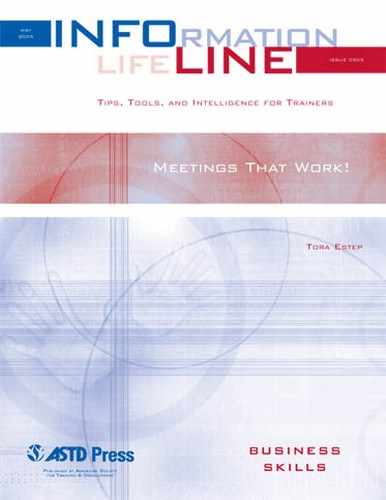You are planning to call a meeting. To help ensure that the meeting is as productive and valuable as it can be, go over this worksheet. You may find you don't even need to call a meeting!
Answer the following questions to determine if a meeting is your best option.
Question | Yes or No? |
|---|---|
Can you clearly state the purpose of your meeting? | |
Do you want input from others to solve a problem, plan a project, or brainstorm? | |
Are you going to act on participants' input? | |
Do you need to deliver information to a lot of people but don't want to write it? | |
Do you want to motivate and energize your team? |
Did you answer “No” to any (or all) of these questions? If so, stop here. You probably don't need to call a meeting. Consider making some phone calls or sending an email or a memo in-stead. If you do need to call a meeting, jot down the purpose of your meeting here:
___________________________________________________________________________________________________________________________
___________________________________________________________________________________________________________________________
___________________________________________________________________________________________________________________________
___________________________________________________________________________________________________________________________
___________________________________________________________________________________________________________________________
Considering what you want to achieve with your meeting, who can make contributions to its success? Who needs to come? List the names of the people you are considering, then note the reason that person should come. If you can't think of a good reason for someone to come, you should probably cross him or her off the list. For optimum efficiency, you probably don't want more than about a half-dozen people to attend, but that does depend somewhat on the kind of meeting you are planning.
Name | Reason to Attend? |
|---|---|
Now that you have decided whom to invite to the meeting, determine if you need someone to carry out any specific tasks in the meeting, such as presenting information or coming up with some preliminary ideas. Also identify who you want to carry out the roles of timekeeper, facilitator, and notetaker.
Task or Role | Name |
|---|---|
Timekeeper | |
Facilitator | |
Notetaker |
To identify the facilities and equipment you might need, answer the following questions:
Do you have a space that's big enough to comfortably accommodate all the participants?
Do you need any special seating arrangements?
Is the meeting going to take long enough to require breaks or refreshments? Should you go off site?
How are you planning to deliver information or have notes taken?
Is the equipment that you need to deliver information available in the room or facilities that you have chosen?
The last component in planning your meeting is determining what is going to happen. To identify the right agenda items in the right quantity (not too many, not too few), answer the following questions:
What has to happen to accomplish your objective?
What is the most important outcome you want from the meeting?
If meeting time were cut in half for some reason, what would be the first thing removed from the agenda?
If this is a follow-on meeting, were agenda items left from the last meeting that should be taken care of?
During which activity are meeting participants going to commit to further action and next steps?
Are there any minor issues that could be quickly cleared up during this meeting?
Now, list the activities. Mark each activity high priority (H) or low (L). You may still want to keep low-priority activities on your agenda, but you will know where to spend more or less time. If possible, go through high-priority activities first both to capitalize on the energy of the group and to ensure that you cover them.
Activity | Priority (H/L) |
|---|---|
